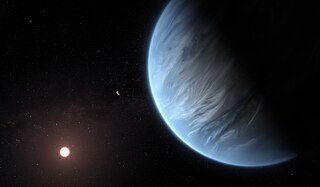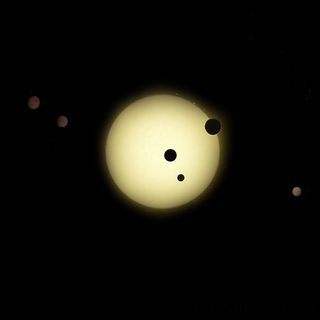Related Research Articles

An exoplanet or extrasolar planet is a planet outside the Solar System. The first possible evidence of an exoplanet was noted in 1917, but was not recognized as such. The first confirmation of detection occurred in 1992. This was followed by the confirmation of a different planet, originally detected in 1988. As of 1 March 2021, there are 4,687 confirmed exoplanets in 3,463 systems, with 770 systems having more than one planet.

WASP or Wide Angle Search for Planets is an international consortium of several academic organisations performing an ultra-wide angle search for exoplanets using transit photometry. The array of robotic telescopes aims to survey the entire sky, simultaneously monitoring many thousands of stars at an apparent visual magnitude from about 7 to 13.
HD 164922 b is an exoplanet orbiting the star HD 164922 about 72 light-years from Earth in the constellation Hercules. Its inclination is not known, and its true mass may be significantly greater than the radial velocity lower limit of 0.36 Jupiter masses. The planet also has a low eccentricity, unlike most other long period extrasolar planets – 0.05 – about the same as Jupiter and Saturn in the Solar System. The exoplanet was found by using the radial velocity method, from radial-velocity measurements via observation of Doppler shifts in the spectrum of the planet's parent star.
HD 154345 is a star in the northern constellation of Hercules. With an apparent visual magnitude of +6.76 it is a challenge to view with the naked eye, but using binoculars it is an easy target. The distance to this star is 59.7 light years based on parallax, but it is drifting closer with a radial velocity of −47 km/s. At least one exoplanet is orbiting this star.

The Transiting Exoplanet Survey Satellite (TESS) is a space telescope for NASA's Explorers program, designed to search for exoplanets using the transit method in an area 400 times larger than that covered by the Kepler mission. It was launched on April 18, 2018, atop a Falcon 9 rocket and was placed into a highly elliptical 13.7-day orbit around the Earth. The first light image from TESS was taken on August 7, 2018, and released publicly on September 17, 2018.

An exoplanet is a planet located outside the Solar System. The first evidence of an exoplanet was noted as early as 1917, but was not recognized as such until 2016. No planet discovery has yet come from that evidence. However, the first scientific detection of an exoplanet began in 1988. Afterwards, the first confirmed detection came in 1992, with the discovery of several terrestrial-mass planets orbiting the pulsar PSR B1257+12. The first confirmation of an exoplanet orbiting a main-sequence star was made in 1995, when a giant planet was found in a four-day orbit around the nearby star 51 Pegasi. Some exoplanets have been imaged directly by telescopes, but the vast majority have been detected through indirect methods, such as the transit method and the radial-velocity method. As of 1 March 2021, there are 4,687 confirmed exoplanets in 3,463 systems, with 770 systems having more than one planet. This is a list of the most notable discoveries.

HD 219134 b is one of at least five exoplanets orbiting HD 219134, a main-sequence star in the constellation of Cassiopeia. HD 219134 b has a size of about 1.6 R⊕, and a density of 6.4 g/cm3 and orbits at 21.25 light-years away. The exoplanet was initially detected by the instrument HARPS-N of the Italian Telescopio Nazionale Galileo via the radial velocity method and subsequently observed by the Spitzer telescope as transiting in front of its star. The exoplanet has a mass of about 4.5 times that of Earth and orbits its host star every three days. In 2017, it was found that the planet likely hosts an atmosphere.

K2-18b, also known as EPIC 201912552 b, is an exoplanet orbiting the red dwarf K2-18, located 124 light-years (38 pc) away from Earth. The planet, initially discovered with the Kepler space telescope, is about eight times the mass of Earth, and is thus classified as a super Earth. It has a 33-day orbit within the star's habitable zone.

K2-33b is a very young super-Neptune exoplanet, orbiting the pre-main-sequence star K2-33. It was discovered by NASA's Kepler spacecraft on its "Second Light" mission. It is located about 456 light-years away from Earth in the constellation of Scorpius. The exoplanet was found by using the transit method, in which the dimming effect that a planet causes as it crosses in front of its star is measured.
Kepler-1229 is a red dwarf star located about 870 light-years (270 pc) away from the Earth in the constellation of Cygnus. It is known to host a super-Earth exoplanet within its habitable zone, Kepler-1229b, which was discovered in 2016.
K2-72 is a cool red dwarf star of spectral class M2.7V located about 227 light-years (70 pc) away from the Earth in the constellation of Aquarius. It is known to host four planets, all similar in size to Earth, with one of them residing within the habitable zone.
K2-72c is a small exoplanet orbiting around the red dwarf star K2-72 approximately 227.7 light-years away. It is located in the inner edge of the habitable zone. K2-72c completes an orbit in 15.2 days, and it has a radius of only 86% of that of the Earth.
K2-72d is a small exoplanet orbiting around the red dwarf star K2-72 approximately 227.7 light-years away. K2-72d completes an orbit in 7.8 days, and it has a radius of only 73% of that of the Earth.

K2-72e (also known by its EPIC designation EPIC 206209135.04), is a confirmed exoplanet, likely rocky, orbiting within the habitable zone of the red dwarf star K2-72, the outermost of four such planets discovered in the system by NASA's Kepler spacecraft on its "Second Light" mission. It is located about 217.1 light-years (66.56 parsecs, or nearly 2.0538×1015 km) away from Earth in the constellation of Aquarius. The exoplanet was found by using the transit method, in which the dimming effect that a planet causes as it crosses in front of its star is measured.
K2-146 b is a Neptune-like exoplanet discovered in 2018 that orbits a M-type star and is found in the constellation Cancer. It was discovered by the Kepler Space Telescope. It orbits around one low-mass star. It is also the only exoplanet to orbit around K2-146. Namely, it orbits closer to its sun than Mercury does, and that is being 97% closer to its sun than Earth is to ours, it orbits very rapidly and well inside what would be regarded as the 'habitable zone’.

HATS-36 b is a gas giant exoplanet that orbits a F-type star. Its mass is 3.216 Jupiters, it takes 4.2 days to complete one orbit of its star, and is 0.05425 AU from it. It was discovered on June 12, 2017 and was announced in 2018. Its discoverers were 23, namely Daniel Bayliss, Joel Hartman, George Zhou, Gaspar Á. Bakos, Andrew Vanderburg, J. Bento, L. Mancini, S. Ciceri, Rafael Brahm, Andres Jordán, N. Espinoza, M. Rabus, T. G. Tan, K. Penev, W. Bhatti, M. de Val-Borro, V. Suc, Z. Csubry, Th. Henning, P. Sarkis, J. Lázár, I. Papp, P. Sári.

Tau Ceti f is a super-Earth or mini-Neptune orbiting Tau Ceti that was discovered in 2012 by statistical analyses of the star's variations in radial velocity, based on data obtained using HIRES, AAPS, and HARPS. It is of interest because its orbit places it in Tau Ceti's extended habitable zone, but a 2015 study implies that there may not be a detectable biosignature because it has only been in the temperate zone for less than one billion years.
References
- 1 2 3 4 "K2-72b CONFIRMED PLANET OVERVIEW PAGE". NASA Exoplanet Archive. Retrieved 2016-07-18.


